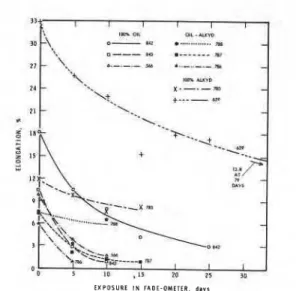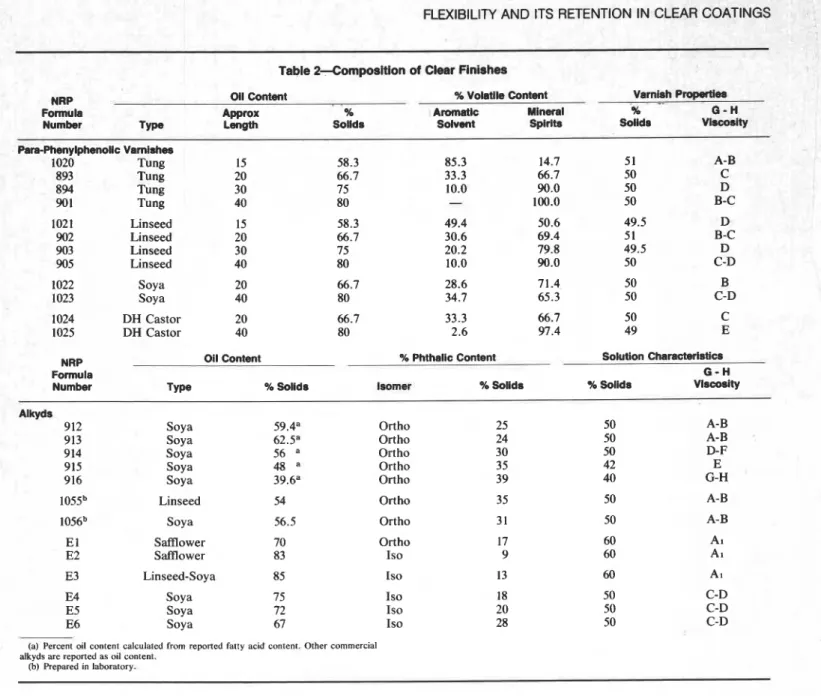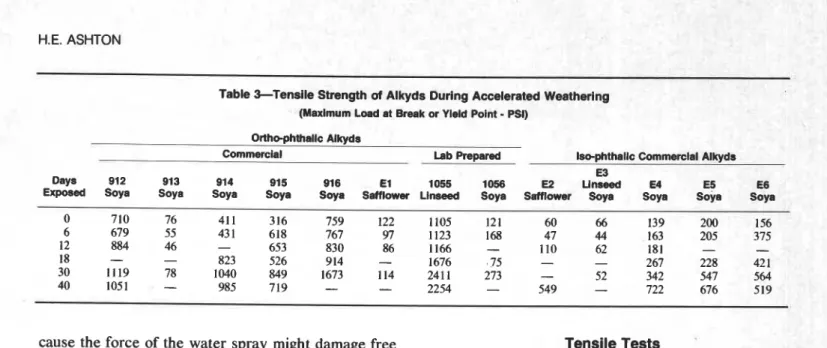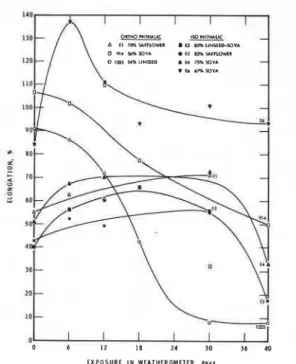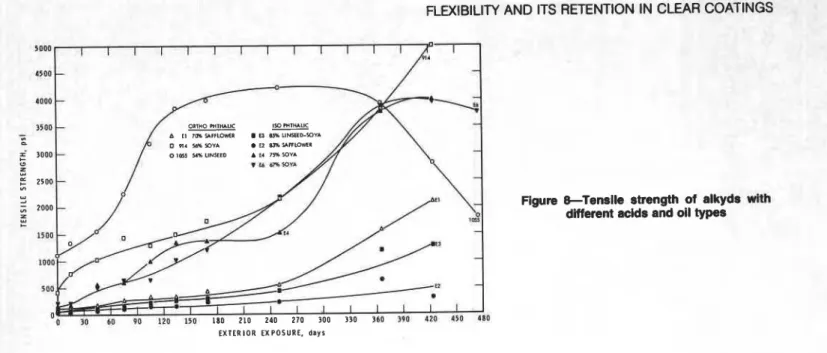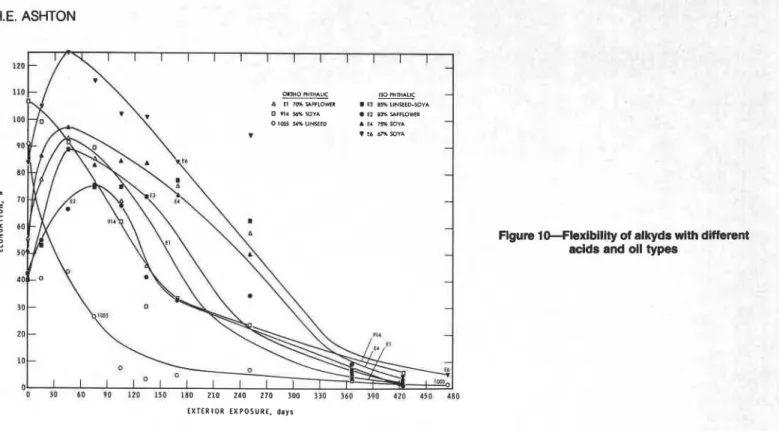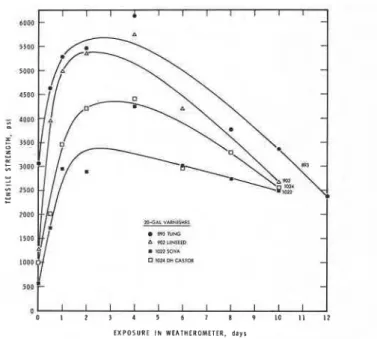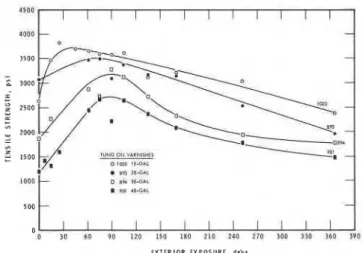Publisher’s version / Version de l'éditeur:
Journal of Coatings Technology, 51, 653, pp. 41-52, 1979-06
READ THESE TERMS AND CONDITIONS CAREFULLY BEFORE USING THIS WEBSITE. https://nrc-publications.canada.ca/eng/copyright
Vous avez des questions? Nous pouvons vous aider. Pour communiquer directement avec un auteur, consultez la première page de la revue dans laquelle son article a été publié afin de trouver ses coordonnées. Si vous n’arrivez pas à les repérer, communiquez avec nous à PublicationsArchive-ArchivesPublications@nrc-cnrc.gc.ca.
Questions? Contact the NRC Publications Archive team at
PublicationsArchive-ArchivesPublications@nrc-cnrc.gc.ca. If you wish to email the authors directly, please see the first page of the publication for their contact information.
Archives des publications du CNRC
This publication could be one of several versions: author’s original, accepted manuscript or the publisher’s version. / La version de cette publication peut être l’une des suivantes : la version prépublication de l’auteur, la version acceptée du manuscrit ou la version de l’éditeur.
Access and use of this website and the material on it are subject to the Terms and Conditions set forth at
Flexibility and its retention in clear coatings exposed to weathering
Ashton, H. E.
https://publications-cnrc.canada.ca/fra/droits
L’accès à ce site Web et l’utilisation de son contenu sont assujettis aux conditions présentées dans le site LISEZ CES CONDITIONS ATTENTIVEMENT AVANT D’UTILISER CE SITE WEB.
NRC Publications Record / Notice d'Archives des publications de CNRC:
https://nrc-publications.canada.ca/eng/view/object/?id=e7425dc4-1d3c-4620-90f9-4dd37b9ee796 https://publications-cnrc.canada.ca/fra/voir/objet/?id=e7425dc4-1d3c-4620-90f9-4dd37b9ee796
S e r
TH1
N21d
National Research Council of Canada
00.856lop. 2
-,a3 .i.B,
Conseil national de recherches du Canada
-- -
FLEXIBILITY AND ITS RETENTION IN CLEAR
COATINGS EXPOSED TO WEATHERING
Reprinted from
Journal of Coatings Technology Vol. 51, No. 653, June 1979 p. 41
-
52DBR Paper No. 856
Division of Building Research
L'influence des proprietks mecaniques sur le comportement des revetements en service est gentralement etablie bien que I'importance de ces proprietis, en particulier la souplesse, attribuee a certains liants n'ait jamais donne de mesures reelles. La resistance a la traction et I'allongement des resines alkydes claires, des vernis phenoliques et de leurs modifications ont Cte determines au moyen de pellicules libres exposees au vieillissement normal et au vieillissement accelere. I1 a Ctt demontre que les resines alkydes a teneur en huile moyenne ont une meilleure extensibilite et la conservent mieux que les resines a teneur en huile faible ou elevee. Les resines phenoliques ne demeurent pas souples tres longtemps pendant aucune des expositions et la modification phenolique des resines reduit nettement I'allongement. Le rap- port entre les proprietes de traction et le rendement du bois a I'extCrieur est discute dans cet article.
Flexibility and Its Retention
In Clear Coatings
Exposed to Weathering
H. E. Ashton
National Research Council of Canada*
The influence ot mechanical properties on the behavior of coatings in service is generally understood. However, the level of these properties, particularly flexibility, attributed to some binders has not reflected actual measurements. Tensile strength and elongation of clear alkyds and phenolic varnishes have been.deBrmind using free f i tms exposed to natural or accelerated weathering. It is shown that alkyds of intermediate oil content have higher exten- sibility and retain it better than those with low or high oil content, while phenolics do not remain flexible for very long in either exposure. The relation of tensile properties to exterior performance on wood is discussed.
INTRODUCTION
Because it developed
from
an art formwith closely
guarded secrets, the coatings industry seems to hold on longer than other industries to beliefs that do not stand up to scientific investigation. Long after a particular
tenet has been proved false, it may continue to be
repeated
in
the coatings industry as accepted fact.One example of such beliefs is that "drying oils pro-
vide added flexibility to coatings
films."
In the field ofart this was, of course, true for s e v e d centuries. Oils are flexible in comparison with the other binders that had previously been used: glue, casein, egg white, and
egg yolk. Improved flexibility was probably one reason why oil paints superseded tempera, which was an emul-
sion of oil in water with egg yolk acting as the emulsifier and protective colloid. The difference between the
Presented at the Polymer Conference, University of Detroit, June 13, 1979. *Division of Building Research, Ottawa, Ontario, Canada KIA 0R6.
mechanical properties of oil and those of the other binders was certainly the basis for the old artists' rule,
fat on lean, but never lean on fat, i.e., do not topcoat a
softdrying material with a hard-drying material (unless
the aim is to produce a wrinkle or alligator finish).
Oils are also more flexible than the hard resins used to
produce the oleoresinous finishes introduced after oil
paints were developed. This difference in flexibility was
the basis of the old kauri test in which a hard, natural resin is added to a varnish until it cracks when bent over
a narrow rod. The hypothesis was that the more hard
resin that could be added, the more durable was the
original varnish. This was correct when the test was first developed because the natural resins then in use
were not so durable as the oils. The introduction
of
pure, oil-soluble phenolic resins, however, changed the relationship between oil content and durability. Expo-
sure studies of clear finishes for exterior wood carried
out at DBWNRC showed that the durability oftung and
linseed p-phenylphenolic varnishes reaches
a
maxi-mum at oil contents of 58 to 66% by weight.' Subse-
quent accelerated weathering tests have confirmed
these results. Despite this work, kauri reduction still appears as a requirement in exterior varnish specifi- cations and the method is retained by ASTM.
With the invention of alkyds, the continuing belief that drying oils are more flexible than resins becomes
even less tenable when studied carefully. In an alkyd,
part of the polymer is formed during the cooking of the
resin. Because the resin portion is tougher and not so
brittle as the resins used in oleoresinous finishes, less
oil or fatty acid is needed in their production.
For
E X P O S U R E IN F&OE-OMETER. d a y s
Figure 1-Elongation of pigmented coatings
example, an alkyd containing 60% oil is considered to have a high oil content (long oil length), but an oleores- inous binder with the same oil content is said to be of
medium
length. Owingto
the greater proportion of pre-polymer in alkyds, there is less dependence upon air drying for complete film curing so that semi-drying oils
can be used. yet, drying is more rapid than for a straight
drying oil. Because of the lower oil content and possibly lower unsaturation, the resultant films oxidize less
during aging or weathering and retain flexibility better than a binder composed completely of oil. In spite of this, some specifications for alkyd finishes for exterior wood prohibit lowering the oil content (increasing the phthalic content) because the oil is supposed to provide the flexibility needed on a wood surface.
More than 15 years ago, work carried out at DBR/
NRCZ showed that pigmented alkyd finishes had higher
initial extensibility than linseed oil paints and retained
their extensibility better when exposed to artificial sun- light (Figure 1). Part of the difference in elongation was
due to lower pigment volume concentration (PVC), as
Figure 2-Test fence panels of oil paint (NRP 566), top, and alkyd (NRP 659), bottom, after 7 years' exposure
shown in Table 1. In addition, the tensile machine then in use was not very sensitive and the rate of loading could not be controlled because the movement of the lower grip varied according to the tensile properties of the film being tested. Nevertheless, the results did indi- cate that alkyds should be suitable for use on exterior wood siding. Exposure tests3 on various wood sub- strates confirmed the superiority of the alkyd, as illus- trated in Figure 2. In practice, however, they only came into wide use for this purpose in North America about ten years later when the price of linseed oil increased by more than 400%.
Some of the studies on clear finishes illustrate more explicitly the relation between oil content and flexi- bility, especially of alkyds. The over-all objective was to determine which properties are needed to provide satisfactory performance of clear coatings. Among those considered relevant were initial tensile strength and elongation as well as changes in them with weath- ering. Free films of two types of clear finish were ex- posed to natural and accelerated weathering and their
Table 1--Composition of Pigmented Oil and Alkyd Finishes
NRP Binder Pigmentation
Formula Total Oil Content TYPe
Number Components K N - W a (in order of content) PVC %
842 100% Refined linseed oil
...
100 Basic white lead 31.0carbonate (B WLC)
843 100% Refined linseed oil
...
100 B WLC-ZnO-Talc 29.1 566 70% Raw linseed oil...
100 Talc-BWLC-Zn0-Ti02 33.630% Bodied linseed oil 2-3
786 5 1.6% Refined linseed oil
...
88.9 PbZn-Talc-Ti02 35.4 48.4% Extra long linseed alkyd788 25% Bodied linseed oil Q. ... 88.75 Talc-Ti02 31.4 75% Extra long isophthalic linseed-soya alkyd
787 48.7% Refined linseed oil ... 88.2 Talc-Zn0-Ti02 34.5 51.3% Extra long linseed alkyd
785 100% Extra long linseed alkyd
...
77 Talc-Ti02 29.7 659 100% Long soya alkyd...
65 Ti02 19.6(a) Non-Volatile Vehicle.
FLEXIBILITY AND ITS RETENTION IN CLEAR COATINGS
Table 2--Composttion of Clear Finishes
NRP Oil Content % ~olatlla Content . Varnish Properties ..
Formula Approx % Aromatic Mineral % G - H
Number TYP Length Solids Solvent Spirits Sollds Vlrcoslty Para-Phenylphenollc Vamlshes 1020 Tu ng 893 Tung 894 Tung 901 Tung 1021 Linseed 902 Linseed 903 Linseed 905 Linseed 1022 Soya 1023 Soya 1024 DH Castor 1025 DH Castor A-B C D B-C D B-C D C-D B C-D C E NRP Oil Content % Phthalic Content Solution Characteristics
Formula G - H
Number Type % S ~ I I ~ S konmr % ~ o l i d s K solids v~scosity Alkyds 912 913 914 915 916 10S b 1056b E 1 E2 E3 E4 E5 E6 Soya Soya Soya Soya Soya Linseed Soya Safflower Safflower Linseed-Soya Soya Soya Soya Ortho Ortho Ortho Ortho Ortho Ortho Ortho Ortho Is0 Is0 Is0 Is0 Is0 A-B A-B D-F E G-H A-B A-B A1 A 1 A I C-D C-D C-D
(a) Percent oil content calculated from reported fatty acid content. Other commercial alkyds are reported as oil content.
(b) Prepared in laboratory.
mechanical properties measured at intervals of expo- The coatings were applied to tinfoil using a 6-mil sure. This paper discusses the changes in tensile prop- clearance blade and a mechanical drive equipped with a erties in relation to composition and to performance on perforated suction plate.4 These films were allowed to exterior cedar panels. dry for three weeks in a room conditioned at 73.5
+3.5OF (23 k2"C) and 50 +5% RH.
EXPERIMENTAL Accelerated Weathering
Materials
The clear finishes were phenolics and alkyds. There were 12 p-phenylphenolic varnishes containing from 58
to 8Wo of one of four different oils. The 13 alkyds, eight based on orthophthalic anhydride and five on isophthalic acid, contained from 39.5 to 85% of three different oils. The varnishes and two of the alkyds were made in the DBR laboratory. The remaining alkyds were purchased from commercial resin producers, with the soya-orthophthalic series all made by the same company. The composition of phenolics and alkyds is summarized in Table 2.
After air drying, the coatings, still on the foil, were mounted carefully on a rack so that no fold could de- velop in the coating during handling and weathering. To determine the effect of accelerated weathering on ten- sile strength and flexibility, the mounted coatings were exposed in a twin carbon-arc Weather-Ometera operating on a cycle of 12 hours light without water and 12 hours very high relative humidity without light. The latter was substituted for the 12-hr water spray in the cycle customarily used in this laboratory to test clear finishes on The substitution was necessary be-
Table %Tensile Strength of Alkyds During Accelerated Weathering
(Maximum Load at Break or Yleld Point
-
PSI) Orthcbphthallc AllydsCommercial
-
Lab Prepared Iso-phthallc Commerclal AlkydsE3
Days 912 913 914 915 916 E l 1055 1056 €2 Unseed E4 Es E6
Exposed Soya Soya Soya Soya Soya Safflower Llnseed Soya Safflower Soya Soya Soya Soya
0 710 76 411 316 759 122 1105 121 60 66 139 200 156 6 679 55 431 618 767 97 1123 168 47 44 163 205 375 12 884 46 - 653 830 86 1166
-
110 62 181 --
18-
- 823 526 914-
1676 * 75-
- 267 228 421 30 1119 78 1040 849 1673 114 2411 273-
52 342 547 564 40 1051-
985 719-
-
2254-
549-
722 676 519cause the force of the water spray might damage free films exposed for any length of time. Subsequent tests on clear finishes on wooden panels showed that with the light-humidity cycle it took twice as long to obtain re- sults the same as those of the light-water spray. The ratio in this study may be closer to one because free films obtained from a single coat would absorb water more rapidly than a three-coat system applied to wood.
Natural Weathering
For outdoor exposure, thick, 8 x 12-in. glass plates were used as supports. As suggested in ASTM D2370, a thin layer of castor oil was applied to one side of the glass plate to hold the coated foil in close contact with it, taking care to avoid applying too much oil. The foil bearing the coating was then placed on the glass plate and the surface completely smoothed with tissue. Ex- cess foil was folded over all four sides of the plate and the coating taped to the plate with waterproof plastic- coated tape, leaving a sufficiently large area for expo- sure.
The mounted clear finishes were exposed at an angle of 45 deg on south-facing racks 4 ft (1.2 m) above the ground at the exposure site of the National Research Council, Ottawa. Exposure of 20 sets of 12 paraphenyl- phenolic varnishes began in July 1968. The same number of sets of 13 alkyd coatings were exposed in August. Twenty sets allowed a total exposure time of about 16 months because of more frequent testing dur- ing the first few months of exposure.
Tensile Tests
At the end of each selected period of natural or accel- erated weathering, one set of each coating was removed from the racks for testing. The other sets were left undisturbed for further exposure. The foil bearing the coating was removed from the support and examined for any damage that might have occurred during expo- sure. It was then placed between two waxed paper sheets and cut into one-inch (25 mm) strips using a Thwing-Albert precision sample cutter. The coating side of the strips was taped at both ends and the strips placed on a mercury bath. When the coatings floated freely after amalgamation of the tin, they were picked up with tweezers at a taped end. Each film was spread on waxed paper and the original underside carefully cleaned with a camel hair brush. To obtain a relatively clean surface and permit easy handling of the free film on mercury, it was necessary to use a large amount of mercury in a spacious amalgamation bath.
The one-inch wide strip of the unsupported coating was taped on both sides at each end to provide a 3-in. (76 mm) gauge length. The waterproof plastic-coated pressure-sensitive cloth tape also acted as a grip for the jaws of the tensile machine. The test specimens were pulled on a Tinius-Olsen U-Ce1tronicm tensile tester equipped with a 12,000 g cell. This machine allows the load to be decreased in steps down t o 120 g for full-scale deflection. It was usually operated in the 600, 1200, or 2400 g range depending upon the strength of the coat- ing. In most cases the coating was pulled at a strain rate
Table 4--Flexibility Properties of Alkyds During Accelerated Weathering
(Maximum Elongation at Break
-
Per cent) Ortho-phthalic AlkydsCommercial
-
Lab .Prepared Iso-phthaFc Commerclal Alkyds€3
Days 912 913 914 91 5 91 6 E l 1055 1056 €2 Linseed €4 E5 €6
FLEXlBlLlN AND ITS RETENTION IN CLEAR COATINGS
E X P O S U R E I N W E A T H E R O M E T E R . d a y s E X P O S U R E IN W E A T H E R O M E T E R . d a y r
Flgure 4-Tenslle strength of alkyds with different acids and oil
Figure %Tensile strength of alkyds with different oil contents types
of 0.12 in. (3 mm) per minute, which is 4% of the gauge length per minute.
The maximum load in grams applied to the one-inch wide strip of the coating at either break or deformation (yield point) was determined directly from the record- ing chart on the machine. Tensile strength was calcu- lated in terms of pounds per square inch and expressed as the maximum load at the ~ o i n t of break or yield.
The maximum extension in the length of the test specimen at the point of break was taken as the measure of flexibility of the coating. Extension in length was determined from the rate of strain and the time required for breaking to occur. Elongation was calculated as the per cent increase in the gauge length of the coating and reported as percent elongation.
Because of the variability encountered in tensile tests conducted on thin films of organic coatings, it had been planned to use at least ten specimens of each material for one test. With some coatings exposed to accelerated or natural weathering for fairly long periods, however, the number of test specimens was reduced because those that developed defects were discarded. For example, most phenolic coatings exposed in the Weather-Ometer for more than 12 cycles or outdoors for more than one year became so brittle that they broke either in the process of removing them from the amal- gamation bath or while mounting them on the tensile tester. Because of this, the resultsfor coatings of longer exposure time were obtained from a limited number of specimens or could not be obtained at all.
When results from an individual specimen were low for both elongation and tensile strength, compared with other specimens of the same material subjected to the same weathering period, they were rejected. The pro- cedure described in ASTM D2370 requires that the lowest five results be discarded automatically, regard- less of how they differ from the others. Some difficulty was experienced in selecting results from specimens weathered for fairly long periods. In most tests where thespecimen broke in the approximate center of the gauge length, the results were taken as reliable. Speci- mens of coatings that were weathered for a long period,
however, frequently shattered completely at the time of break. In such cases the validity of the results was considered questionable and they were not reported. Examples can be seen in the Tables where test data do not agree with those from either the preceding or fol- lowing exposures. They are reported merely to illus- trate the variability encountered in determining the ten- sile strength and flexibility of thin coatings.
RESULTS AND DISCUSSION
Because tensile strength and elongation are inversely related for most organic coatings, it is essential to con- sider both properties at the same time to obtain a more
E X P O S U R E IN WEATHEROMETER, d a y r
A El lm WALOWtl U 8% LINSEED-IOIA D n. aa
.
12 m w r r ~ o w ~ 0 IOII 54% LINYID.
* 75% 50".-
BO % $0 0 6 1 2 11 2 4 3 0 3 6 4 0 E X P O S U R E I N W E A T H E R O M E T E R , d a y sFigure GFlexibility of alkyds with different acids and oil types
complete picture of their mechanical properties. For example, high tensile strength is only beneficial if it is accompanied by a fair amount of elongation; otherwise the material is brittle. Conversely, high elongation re- quires a reasonable level of tensile strength or the coat- ing will be weak. If a material has both high tensile strength and high elongation, it is considered tough, but this combination is the exception with organic coatings.
Because of the effect of one mechanical property upon the other, it would be preferable to combine the two in a single factor. This is sometimes done by inte- grating the area under the stress-strain curve and con- sidering the result as a measure of toughness. Theoreti- cally, the best way to treat the tensile properties of viscoelastic materials is by means of failure envelope^.^
Figure 7-Tensile strength of alkyds with different oil contents
This, however, is not normal practice because of the large number of tests required to define the failure en- velope completely. Consequently, the results obtained in this study will be presented in the usual terms of tensile strength and elongation.
Effect of Weathering On Tensile Properties of Alkyds
ACCELERATED WEATHERING (AW): The tensile strengths and elongation results from clear alkyd films exposed to AW are given in Tables 3 and 4. Curves for most of these finishes are plotted in Figures 3 to 6. In general, alkyds have low tensile strengths that increase with longer exposure, except for the long oil ortho alkyds and very long oil iso alkyds. Flexibility changes caused by AW vary with the resin: elongation of lower oil content alkyds tends to decrease continuously, while that of higher oil content alkyds generally goes through a maximum before decreasing.
The effect of oil content on tensile strength is illus- trated in Figure 3, where the type of oil and dibasic acid are the same, and in Figure 4, for different oils and acids. In the former, the tensile strengths of the alkyds with the highest and lowest oil contents are in the ex- pected order, but the three with intermediate oil con- tents, although fairly similar, are reversed. The lab- oratory-prepared linseed ortho alkyd had the highest tensile strength of all the alkyds tested. Corresponding soya alkyds of similar (914) or lower (916) oil content show the same type of weather-induced changes in strength but at lower levels.
Tensile strengths of isophthalic alkyds are in the ex- pected order, except after 40 days of exposure. There is a larger difference between the two longest iso alkyds than might be expected, E3 remaining weak but E2
gradually increasing in strength. There is a trend for iso alkyds to have somewhat higher tensile strengths than ortho alkyds of similar or even lower oil content (E6 vs.
913, E2 vs. El). Both the longest ortho and iso alkyds have very little strength, but the latter contains 15% /
more oil. 3Wt ROO 2000 1500 10BO ZW P E X T E R I O R EXPOSURE, d a y s i
FLEXIBILITY AND ITS RETENTION IN CLEAR COATINGS
o 914 %SOYA 12 YCWWTR
0 lOIS 54% LINSTTD A 14 7% SOYA
0, 1 U m w w
E X T E R I O R EXPOSURE, days
The elongation results are very different from those suggested by the "oil-is-flexible" hypothesis. The short oil alkyd with the highest tensile strength also has the greatest initial elongation (Figure 5). This eventually drops to the lowest, however, in keeping with the marked increase in strength. In this group the 62.5%
soya alkyd, which has very little strength, has also the lowest flexibility during most of the exposure, while the alkyd with the second lowest oil content has the second highest flexibility. As with tensile strength, the medium soya and linseed alkyds behave similarly, with the latter having lower flexibility. This is attributed to differences in reactivity of the oils, since oil contents are nearly the same.
With the iso alkyds, that with the lowest oil content has high initial flexibility and by far the highest flexi- bility retention (Figure 6). The 75% iso alkyd also has
Figure fflexibility of alkyds with different oil contents
Figure &Tensile strength of alkyds with
diierent acids and oil types
somewhat higher extensibility than the two longest iso resins, but this was not the case with the 72% alkyd.
The increase in flexibility of many of the alkyds dur- ing the first stages of AW is attributed to toughening by crosslinking. Initially, the films were soft and rela- tively weak, so that they broke at lower loads and extensions. The poor mechanical properties of long and very long alkyds are consistent with the proposition7 that in such resins some of the oil is present as a mixture only, and is not chemically bonded to the alkyd molecule. During drying some crosslinks form, but not enough to increase tensile strength appreciably. The higher strengths and good flexibility of the long oil iso alkyds suggest that the oil reacts more during prepara- tion to become a part of the molecule. It is known that orthophthalic anhydride tends to form ring compounds, thus reducing formation of chain polymers with higher molecular weights. 120 110 100 O R M O ALKYDS 90 d 913 62.5% SOYA 0 911 59.4% SOYA 0 914 56% SOYA 80 I 91s m SOYA Vlb 39.6% SOY* 70 60 50 40 10 It) 10 D 0 30 60 PO 120 150 180 210 240 270 300 l l D 360 3PO 4?O 450 480 E X T E R I O R E X P O S U R E , d a y s
b € I IW Y R L O M R
.
E3 8% LINSEED-SOYA0 914 54% SOYA €2 03% Y I F W M R
0 lM5 Y9b LINSEED A €4 7% SOYA
V E6 6Rb SOYA
E X T E R I O R E X P O S U R E , days
NATURAL WEATHERING (NW): The tensile strength and elongation results for alkyds exposed to NW are shown in Figures 7 to 10. It is evident that the maximum tensile strength, which was much higher in NW than in AW, was not reached until after a year's exposure. In fact, most of the longer oil alkyds were stillincreasing in tensile strength at the end of the test when flexibility was correspondingly lower.
The order of strength of the ortho alkyds in Figure 7 approximates that of AW (Figure 3), although the shorter alkyds exhibit, after one year, a decrease in strength not evident in the brief AW exposure. Another difference is the moderate increase in strength of the long oil alkyd after six months. The three intermediate resins are in the same relative order in both NW and AW. The linseed alkyd curve in Figure 8 is similar to that of the short soya in Figure 7, i.e., there is a de- crease in strength after one year. Iso alkyds E4 and E6 are comparable in strength, as they were in AW. Simi- larly, E 1 and E3 are comparable, but in NW there is an
Figure lO-Flexibility of alkyds with different acids and oil types
increase in strength after eight months. Only E2 ap- pears to have lower strength in NW, but results were not available for two of the later AW exposure inter- vals.
With regard to oil length and elongation, in Figure 9, the long and short soya ortho alkyds exhibit flexibilities comparable to those in AW, but the others are lower. In NW the long oil alkyd has the highest flexibility, but that with the second highest oil content has the lowest flexibility for the first eight months. Medium length alkyds, 914 and 915, are similar, although the latter, with less oil, is more flexible for the first six months. In Figure 10, the longest ortho alkyd and all the iso alkyds reach a peak in extensibility after about 45 days' exposure. The 70% safflower ortho alkyd is slightly more flexible than the 83% safflower iso alkyd. Again, the shortest iso alkyd, E6, has the highest elongation, although its superiority to E4 is not so marked as in AW. Both are more flexible than the ortho alkyd of compara- ble oil content. As in AW, the ortho alkyd containing
Table &Tensile Strength of Phenolics During Accelerated Weathering
(Maximum Load at Break or Yield Point, psi)
1CGallon 20-Gallon 30-Gallon 40-Gallon
Days 1020 1021 893 902 1022 1024 905 903 901 905 1023 1025
FLEXIBILITY AND ITS RETENTION IN CLEAR COATINGS
Table 6-Flexlblllty Properties of Phenolics During Accelerated Weathering
(Maxlmum Elongation al B m k , per cent)
1 &Gallon 20-Gallon
--
3O-GaIlon 40-GallonDays 1020 1021 893 902 1022 1024 905 903 901 905 1023 1025
Exposed Tung Llnseed Tung Lid Soya DH Castor Tung Llnseed Tung Linseed S o p DH Castor 0 9.1 6.7 8.2 21.7 93.1 75.4 39.7 76.4 12.3 63.8 26.1 53.8 0.5 8.6 6.8 11.2 9.5 27.3 15.9 25.5 27.8 29.1 38.9 47.6 54.5 1 9.4 5.8 9.9 10.1 8.3 9.9 13.8 21.9 9.2 35.9 56.6 64.5 2 8.5 7.5 10.1 7.9 8.3 8.8 8.8 8.4 9.5 24.4 51.6 53.4 4 6.7 5.2 10.6 10.5 8.8 8.5 8.2 8.7 8.6 8.8 32.9 29.5 6 9.6 5.7 5.2 6.2 4.6 4.5 9.7 10.1 9.1 8.7 38.4 34.5 8 5.9 6.4 3.7
-
5.1 5.7 9.1 7.0 7.8 8.9 23.9 25.0 10 5.1 4.0 5.1 4.2 3.9 5.2 6.9 4.9 8.9 8.5 15.5 22.5 12 5.8 2.9 4.4-
-
-
6.0 7.9-
-
-
21.6relatively fast-drying linseed oil lost all flexibility after three months' weathering, at the same time rapidly increasing in tensile strength. This is related more to oil type than to oil content because the corresponding lab- oratory-prepared soya (not illustrated) was similar in elongation to the other medium length soya alkyds, e.g., 914. Of the alkyds tested, iso alkyds E4, E5, and E6 have the best combination of tensile strength and elongation.
Effect of Weathering
On Tensile Properties of Phenolics
ACCELERATED WEATHERING: The tensile strength
and elongation of phenolic varnishes subjected to AW are listed in Tables 5 and 6. Compared to alkyds, phenolics have much higher tensile strength that in- creases much more rapidly d~ ring AW, as illustrated in
Figure 11 (note scale differ-nce). Regardless of oil content or oil type, all varnishzs have much lower flexi- bility than alkyds after afew days of accelerated weath- ering.
Among 20-gal varnishes, that made with tung oil has the highest tensile strength throughout the exposure.
The tensile strength of linseed v a r ~ i s h approaches that
of lung varnish, but for soya ant1 dehydrated castor varnishes it is somewhat lower. With regard to oil con- tents, varnishes with more oil have lower tensile strengths that peak a few days later than do the shorter oil varnishes.
Regardless of oil type, all 20-gal varnishes lose all flexibility after one day AW. Elongations, as well as tensile strengths, of the two short tung varnishes are the same within experimental error throughout the test. Evidently the additional resin did not cause the 15-gal varnish to become more brittle than the 20-gal one. Only the 40-gal soya and DH castor varnishes retain flexibility for more than eight days, which might lead one to conclude that they should perform better than all other phenolics. In fact, their performance on exterior wood is relatively poor; one factor associated with this might be their low tensile strength.
The initial high strength and low elongation of tung varnishes are attributed to the high degree of conju- gated unsaturation present in tung oil. This contributes to rapid drying, so that the film is closer to its final
air-dried properties than are those containing slower drying oils. During weathering radiant energy acceler- ates the drying process. Consequently, all varnishes decrease to low levels of elongation.
The differences in tensile strength show the differ- ences among the oils in reactivity during varnish cook- ing. Tung and linseed react more with the resin, re- sulting in higher tensile strength at all times during exposure. The peak in strength reached after three to four days is most probably related to the processes of crosslinking and chain scission caused by ultraviolet light.s Crosslinking is a continuation of the drying proc- ess, so that at first tensile strength increases. After many of the available sites are used up, chain scission becomes predominant, leading to decreases in molecu- lar size and a correspondingly lower strength.
NATURAL WEATHERING: Examples of the changes in
tensile strength and elongation of phenolic varnishes during NW are given in Figures 12 and 14. With these finishes, the peak tensile strength of naturally weath- ered films is lower and the change more gradual than in
E X P O S U R E I N W E A T H E R O M E T E R , d a y s
Table 7--Flexibility Properties of Phenolics During Natural Weathering (Maximum Elongation al Break, per cent)
1 CGallon 20-Gallon 30-Gallon 40-Gallon
Days 1020 1021 893 902 1022 1024 894 903 601 . 905 1023 1025
EXpOS8d Tung Llnoeed Tung Linseed Soya DH Castor Tung L l d Tung Linseed Soya DH Castor
AW. Changes in extensibility are similar, with little flexibility remaining after four to six weeks' exposure (Table 7).
Figure 12 shows that the peak in tensile strength is at one month for the 15-gal tung varnish, at two months for the 20-gal varnish, and at three months for the 30- and 40-gal varnishes. As in AW, the two shorter varnishes have higher tensile strengths than those containing more oil. The values in peak strength for 893 are 3500 psi for NW and 6115 psi for AW, although the latter is abnormally high in comparison with other AW values. A more realistic value would be 5600 psi, which is still considerably greater than that obtained in NW.
The effect of different oil types on tensile strength is illustrated in Figure 13, where it may be seen that tung and linseed varnishes have similar strengths, except at the initial and final exposures. Soya and DH castor exhibit similar, lower strengths.
The elongation results illustrate why higher oil con- tent is not related to durability of phenolic varnishes. The 20-gal varnishes made with all four oils had the same low level of flexibility after 15 days' exposure. The varnishes containing 80% oil, however, also have
low elongation after 45 days NW (Figure 14). Because all varnishes, whether short or long oil, become rela- tively inflexible within less than two months of weath- ering, high oil content cannot be important to durabil- ity. Other factors must be responsible for some of the varnishes being more durable.
Comparison of Natural And Accelerated Weathering
In general, the time-dependent change in flexibility of the different coatings was fairly comparable in both exposures. Differences in apparent behavior of alkyds can be attributed in part to the short length of the artificial test compared with the period of natural weathering. For example, E6 would have almost the same curve in Figure 10 as in Figure 6 if the natural exposure were terminated at 250 days.
The tensile strengths are in the same relative order within a group, but phenolic coatings have higher val- ues in AW while alkyds are higher in NW. (In making comparisons, note the difference in the psi scale in certain figures.) This difference in behavior may occur if phenolics absorb more UV radiation in the acceler- ated test than they do on exterior exposure. It is known that the carbon arc produces two large peaks in the near
E X T E R I O R E X P O S U R E , days
Figure 12-Tensile strength of tung phenolics with different oil contents
'I
:BI
I 0 0 2 3 3:.E X T E R I O R EXPOSURE. d a y s
FLEXIBILITY AND ITS RETENTION IN CLEAR COATINGS
UV that are not present in sunlight and that phenolics absorb more towards the visible region than do alkyds. Perhaps the radiation level in the accelerated test is too intense for the proper evaluation of phenolics. The only logical explanation of why alkyds are lower in tensile strength in AW, where the intensity of radiation is greater, is that the accelerated test was not long enough to allow them to reach the maximum strength.
Tensile Properties in Relation To Performance on Exterior Wood
Only clear finishes with NRP code numbers from 893 to 916, plus E3, had been exposed at Ottawa on red cedar panels in the second exposure series.' Measure- ment of physical properties to see which, if any, were related to performance commenced later, after other materials had been added because the exposure results indicated they were needed to supplement the original group. Consequently, it is not possible to relate the mechanical properties of all the materials tested to their actual performance on the test fence.
In the ortho alkyd series, 912 and 914 had the best combination of tensile strength and elongation in AW. In NW, the long soya, 913, had better elongation but its strength was much lower than that of the medium al- kyds. After two years' exposure on wood, 912 and 914 had the highest durability ratings, being about the same, while 913 was poorer in performance. The 85% linseed-soya iso alkyd, E3 (same resin as 91 1 in Ref. I), with AW tensile properties similar to those of 913, had about the same durability on wood. The short soya alkyd that exhibited a marked increase in tensile strength and a rapid decrease in elongation in both AW and NW had the lowest durability rating of alkyds applied to cedar. The latter result agrees with those of Schurr, et al.9
The relation between tensile strength changes and durability of phenolics, however, was completely the reverse of that predicted by Schurr. The short oil phenolic that exhibited the most rapid increase and decrease in tensile strength was also the most durable.
E X T E R I O R E X P O S U R t , days
Figure 14--Flexibility of phenolics with different oil types
H.E. ASHTON is a graduate of the Univer- sity of British Columbia, and was em- ployed for seven years by General Paint Corp. of Canada, Vancouver, B.C. Since 1956, he has been with the Div. of Building Research, National Research Council of I
Canada, and is at present Senior Research Officer and Assistant Head, Building Mate- rials Section. Mr. Ashton was a guest worker at the Paint Research Station, Teddington. England. in 1963-64. He is a member of the Montreal Society for Coat- ings Technology, ASTM Committee D-1, Chairman of the Test Methods subcom- mittee of the Canadian Government Spec- ifications Board Paint Committee, and Chairman of the Canadian Advisory Com- mittee on IS0 Technical Committee 35.
With phenolics, the peak in tensile strength appears to be more closely related to durability as shown by com- paring the 20-gal tung and linseed varnishes with each other and with those containing more of these oils. Similarly, the 40-gal tung with more strength than the 40-gal linseed was the more durable of the two. Tung varnishes were also superior to those made with soya and DH castor in the first exposure series.' There was, of course, no correlation between durability and elon- gation results because all varnishes lost flexibility shortly after being exposed.
CONCLUSIONS
Using elongation at break as the measure of flexi- bility, this study shows that high oil content in alkyds does not lead to greater initial flexibility or to better flexibility retention during weathering. In fact, there is an optimum oil content for extensibility at about 56 to
60% oil for soya ortho alkyds that corresponds to better durability results on exterior wood. This is similar to p-phenylphenolic varnishes, the durability of which peaks at 58 to 66% oil. With iso alkyds the best combi- nation of tensile strength and elongation occurs at 67 to 75% oil, but in this study there were no iso alkyds with less thar, 67% oil. Iso alkyds had a better combination of tensile properties than ortho alkyds of equivalent oil length. Ortho alkyds of high oil content and iso alkyds of very high oil content had low tensile strengths with- out a corresponding increase in flexibility. This is con- sidered to confirm that in such alkyds some of the oil is present as a mixture only.
Both tensile strength and flexibility and their changes with exposure time are related to the durability of al- kyds. Only strength correlates with the performance of p-phenylphenolics, as almost all varnish films had little flexibility after a short exposure to either natural or accelerated weathering. The high oil content varnishes that retained flexibility longest in the group are the least durable as clear coatings.
The high oil content coatings are soft after air drying for six weeks or more. Consequently, when first sub-
jected to the tensile test they broke before being stretched to their potential maximum elongation. Dur- ing natural and accelerated weathering they became somewhat tougher and were able to extend more before breaking. Hence, they exhibited an increase in flexi- bility in early exposure periods.
Alkyds had lower tensile strengths than phenolics in AW, but in NW the maximum strength of all but long ortho and very long iso alkyds was higher than that of phenolics. In both exposures the increase in the strength of alkyds was more gradual than with phenolics. Alkyds were also more flexible and retained this property longer in both tests. On the basis of mechanical properties, 40 cycles of accelerated weath- ering, using the 12-12 cycle but substituting high hu- midity for water spray, were not enough to produce the changes that occurred in alkyds in one year of natural weathering. The accelerated test, however, appears to have had a greater effect on the tensile strength of phenolics. Evidently an exposure cycle applicable to one type of clear finish is not necessarily appropriate to another, at least if free films are being exposed. On the other hand, when testing coated panels, the poor dura- bility of wood may be so dominant that the different response of resins is markedly reduced.
Flexibility is generally considered to be an important property of coatings, particularly those designed for use on substrates subject to relatively large dimensional changes resulting from temperature or humidity var- iations. Radiant energy in accelerated and natural weathering causes marked changes in the mechanical properties of phenolics, which rapidly attain maximum strength with a concomitant loss in flexibility. On the other hand, the tensile properties of most alkyds change at a slower rate and they retain their flexibility for a fairly long period. This basic property of alkyds is one reason for the good exterior performance of pigmented alkyds. Clear alkyds, however, when exposed on wood to natural or accelerated weathering do not perform nearly so well as the short oil phenolics, which have very little elongation. Flexibility, therefore, is not so important as water absorption, water vapor permea- tion, or transparency to UV light in relation to the
performance of clear finishes, even on such a dimen- sionally unstable substrate as wood.
ACKNOWLEDGMENTS
The clear finish experimental results given in this paper were obtained under the direction of M. Yaseen, now of the Regional Research Laboratory, Hyderabad, India, when a post-doctoral fellow working with the author at the National Research Council of Canada. The preparation of the varnishes and the films by G.A. O'Doherty, L.R. Dubois, and R.C. Seeley is acknowl- edged with thanks. Mr. Seeley also measured the mechanical properties of the films.
This paper is a contribution from the Division of Building Research, National Research Council of Canada, and is published with the approval of the Di- rector of the Division.
References
(I) Ashton, H.E., "Clear Finishes for Exterior Wood: Field Expo- sure Tests," JOURNAL OF PAINT TECHNOLOGY, 39, NO. 507, 212 (1%7).
(2) Harris, J., "A Study of House Paint Properties," Canadian Paint and Varnish, 37, No. 2 , p 22 and No. 3, p 42 (1%3).
(3) Ashton, H.E., "Paint Tests," Canadian Paint and Finishing, 33,
No. 8, 43 (1969).
(4) Yaseen, M. and Ashton, H.E., "Effect of Free Film Preparation Method on Physical Properties of Organic Coatings," JOURNAL
OF COATINGS TECHNOLOGY, 49, NO. 629, 50 (1977).
(5) Ashton, H.E., "Accelerated Testing and Organic Coatings,"
Paint and Varnish Production, 59, No. 9, 34 (1%9).
(6) Zorll, U., "Failure Envelopes of Paint Film as Related to Pig- mentation and Swelling." XITH FATIPEC Congress, Florence, 1972. (National Research Council of Canada, Ottawa, Technical Translation 1787, 1975.)
(7) Payne, H.F., "Organic Coating Technology," Vol. 1, p 292, Wiley, New York 1954.
(8) Ashton, H.E., "The Weathering of Organic Building Materials,"
I n "Progress in Construction Science and Technology," No. 1, (ed. by P.J. Horrobin and J.W. Simpson), Medical and Technical Publishing Co., Lancaster, England 1971.
(9) Schurr, G.G., Hay, T.K., and Van Loo, M., "Predicting Exterior Durability by StresslStrain Measurements," JOURNAL OF PAINT
This publication is being distributed by the Division of Building Research of the National Research Council of Canada. It should not be reproduced in whole or in part without permission of the original publisher. The Division would be glad to be of assistance in obtaining such permission.
Publications of the Division may be obtained by mailing the appropri- ate remittance (a Bank, Express, or Post Office Money Order, or a cheque, made payable to the Receiver General of Canada, credit NRC) to the National Research Council of Canada, Ottawa. KIA
0R6. Stamps are not acceptable.
A list of all publications of the Division is available and may be obtainell from the Publications Section, Division of Building Re- search, Yational Research Council of Canada, Ottawa. KIA 0R6.
